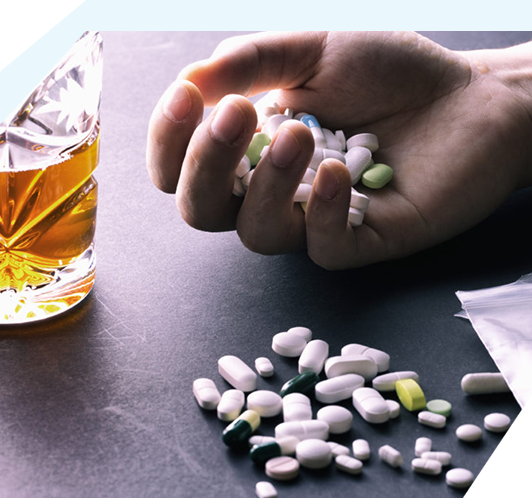Inpatient Drug and
Alcohol Rehab Treatment Near Me
in Bel Air South Maryland
Residential Alcohol & Drug
Rehab Near You
People with substance use disorders struggle to control their drug and alcohol intake, and this often develops into addiction. Addiction is a disease that prevents a person from quitting a certain substance even if they want to. This is why proper addiction treatment is necessary for those who are struggling with the effects of addiction and substance abuse.
The treatment process dives deep into the addicted individual’s condition, creating a personalized plan that is based on their specific needs. A drug and alcohol addiction treatment program will assess the patient and get to the bottom of their addictive behavior, including their triggers, the causes of their substance abuse, and any co-occurring mental health disorders.
Everyone is different. People are affected by addiction in different ways. This is why inpatient addiction treatment centers take a closer look at the patient’s condition to see if there are underlying conditions that are making them .LEARN MORE
Drug and Alcohol
Addiction
Addiction is also known as substance use disorder. It is a progressive disease that is characterized by the inability to quit a particular substance, even when that person is already suffering from its adverse effects. Their symptoms will worsen, but they will only continue on that spiral because they have no control over their intake. LEARN MORE


Why Do People Abuse
Drugs and Alcohol?
There are a lot of factors that influence the development of a substance use disorder or addiction. One reason is the way the addictive substance interacts with the brain, activating its reward center and making the person feel more relaxed and euphoric. LEARN MORE
Addiction Treatment for
Drug and Alcohol Abuse
There are several treatment programs and therapies for substance use disorder. Even for severe cases, treatment can go a long way. And it all starts with admitting that you have a problem that needs to be addressed.
A lot of addicted individuals struggle with this, denying that they have a drug or alcohol problem.LEARN MORE


What is Inpatient
Treatment?
Inpatient drug rehab, also known as residential treatment, involves staying in a rehab facility for the duration of the treatment program. Compared to outpatient rehab, an inpatient rehab program is more intensive and structured. It is mainly designed to treat severe cases of addiction.
LEARN MORE
What to Expect from
Inpatient Drug Rehab
During inpatient addiction treatment, residents follow a specific schedule. They undergo several treatments and therapies throughout the day. This structured approach can help most individuals who have been affected by addiction, given the fact that this medical condition can make someone lose control over their daily lives, and make each day feel chaotic. LEARN MORE

What is Outpatient Treatment?
Outpatient rehab is an alternative to inpatient treatment, which offers the same type of treatment programs and therapies, but does not require patients to stay in the treatment facility for the entire program. As a part-time program, outpatient rehab is less restrictive.
What to Expect from Outpatient
Drug Rehab
Outpatient rehab offers similar treatment for drug addiction and alcohol addiction. It’s just a matter of what kind of schedule works best for the patient and how severe their condition is. Some patients start off in an inpatient treatment program and move to an outpatient rehab program after making significant progress.
Patients continue to live at home. Since outpatient rehab does not provide food and accommodations, it is generally more affordable than inpatient treatment. LEARN MORE
About Bel Air South
Rehab Treatments In Bel Air South Maryland
- Alcohol Addiction Bel Air South
- Alcohol Detox Bel Air South
- Alcohol Rehab Bel Air South
- Alcohol Rehab for Veterans Bel Air South
- Finding the Best Alcoholism Rehab Near Me in Bel Air South
- AA Free & Confidential Alcoholics Anonymous Helpline Bel Air South
- Benzodiazepines Rehab Near Me Bel Air South
- Christian Drug Rehab Bel Air South
- Drug Rehab-addiction Treatment Centers Near You Bel Air South
- Dual Diagnosis Treatment Centers Near You Bel Air South
- (EAP) Employee Assistance Programs Bel Air South
- Fentanyl Bel Air South
- Find 30-Day Inpatient Drug Rehabs Near You! Bel Air South
- Find 60 Day Inpatient Drug Rehabs Near You! Bel Air South
- Find 90 Day Inpatient Drug Rehabs Near You! Bel Air South
- Hydrocodone Bel Air South
- Inpatient Drug and Alcohol Rehab Near Me Bel Air South
- Inpatient Drug Rehab Treatment Program Bel Air South
- Luxury Drug & Alcohol Addiction Treatment Centers Bel Air South
- Mental Health, Addiction, and Drug Rehab Bel Air South
- NA Hotline, Narcotics Anonymous 24 Hour Hotline Bel Air South
- Online Therapy|Mental Health|Substance Abuse|Dual Diagnosis Bel Air South
- Mental Health Online Therapy | Teletheraphy Bel Air South
- Outpatient Drug Rehab Near Me Bel Air South
- Oxymorphone Bel Air South
- Prescription Drugs Bel Air South
- Student Drug Rehab Bel Air South
About Maryland
Browse by State
- ALABAMA
- ALASKA
- ARIZONA
- ARKANSAS
- CALIFORNIA
- COLORADO
- CONNECTICUT
- DELAWARE
- FLORIDA
- GEORGIA
- HAWAII
- IDAHO
- ILLINOIS
- INDIANA
- IOWA
- KANSAS
- KENTUCKY
- LOUISIANA
- MAINE
- MARYLAND
- MASSACHUSETTS
- MICHIGAN
- MINNESOTA
- MISSISSIPPI
- MISSOURI
- MONTANA
- NEBRASKA
- NEVADA
- NEW HAMPSHIRE
- NEW JERSEY
- NEW MEXICO
- NEW YORK
- NORTH CAROLINA
- NORTH DAKOTA
- OHIO
- OKLAHOMA
- OREGON
- PENNSYLVANIA
- RHODE ISLAND
- SOUTH CAROLINA
- SOUTH DAKOTA
- TENNESSEE
- TEXAS
- UTAH
- VERMONT
- VIRGINIA
- WASHINGTON
- WEST VIRGINIA
- WISCONSIN
- WYOMING

